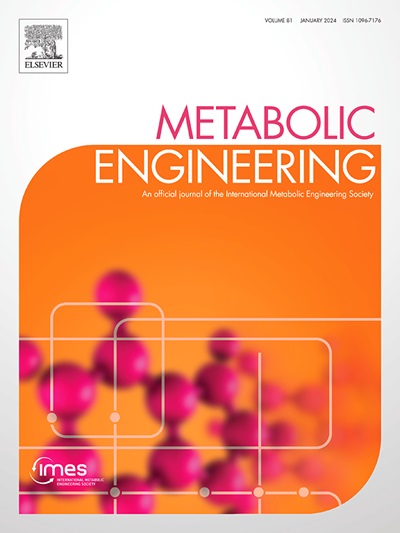Elucidation of the plant progesterone biosynthetic pathway and its application in a yeast cell factory
IF 6.8
1区 生物学
Q1 BIOTECHNOLOGY & APPLIED MICROBIOLOGY
引用次数: 0
Abstract
Progesterone and its steroidal derivatives, including androgens, estrogens, glucocorticoids and mineralocorticoids are extensively utilized in pharmacotherapy, serving as predominant agents in anti-inflammatory, contraceptive, and anticancer treatments. From the 1990s to the present, scientists attempted to biosynthesize steroids such as progesterone and hydrocortisone from sugars in engineered microbial strains expressing pathway enzymes derived from animal sources. However, the low activity of the cytochrome P450 sterol side-chain cleavage (P450scc) system and their mitochondrial compartmentalization have limited the development of this route. Therefore, discovering an efficient P450scc system and developing innovative strategies will be necessary to overcome this bottleneck. Here, we elucidated the complete biosynthetic pathway of progesterone in Marsdenia tenacissima, a medicinal plant rich in steroids. The pathway comprises four enzymes, the two P450scc enzymes MtCYP108 and MtCYP150, as well as the two 3β-hydroxysteroid dehydrogenase/Δ5-Δ4 isomerases (HSDs) MtHSD5 and MtHSD6. Unlike their animal counterparts, the plant-derived P450scc enzymes were found to be localized to the endoplasmic reticulum in yeast and plants, and using the plant-type cytochrome P450 reductase (CPR) as electron transfer chain. The plant-derived HSDs are cytoplasmic in yeast and plants, whereas animal-derived HSDs localize to the endoplasmic reticulum. Based on this discovery, we engineered a yeast-based cell factory capable of synthesizing 1.06 g/L of progesterone from a simple carbon source. This discovery lays the groundwork for the sustainable synthesis of steroid hormone drugs through the use of plant-based systems or microbial host cells.
植物黄体酮生物合成途径的阐明及其在酵母细胞工厂中的应用。
黄体酮及其甾体衍生物,包括雄激素、雌激素、糖皮质激素和矿物皮质激素,广泛应用于药物治疗,作为抗炎、避孕和抗癌治疗的主要药物。从20世纪90年代到现在,科学家们试图在表达来自动物来源的途径酶的工程微生物菌株中从糖中合成类固醇,如黄体酮和氢化可的松。然而,细胞色素P450甾醇侧链切割(P450scc)系统的低活性及其线粒体区隔化限制了这一途径的发展。因此,发现一个高效的P450scc系统和开发创新的策略将是克服这一瓶颈的必要条件。本研究阐明了黄体酮的完整生物合成途径,黄体酮是一种富含类固醇的药用植物。该途径包括4种酶,两种P450scc酶MtCYP108和MtCYP150,以及两种3β-羟基类固醇脱氢酶/Δ5-Δ4异构酶MtHSD5和MtHSD6。与动物不同的是,植物来源的P450scc定位于酵母和植物的内质网,并使用植物型细胞色素P450还原酶(CPR)作为电子传递链。植物源性HSDs存在于酵母和植物的细胞质中,而动物源性HSDs则定位于内质网。根据这一发现,我们设计了一个基于酵母的细胞工厂,能够从一个简单的碳源合成1.06 g/L的黄体酮。这一发现为利用植物系统或微生物宿主细胞可持续合成类固醇激素药物奠定了基础。
本文章由计算机程序翻译,如有差异,请以英文原文为准。
求助全文
约1分钟内获得全文
求助全文
来源期刊

Metabolic engineering
工程技术-生物工程与应用微生物
CiteScore
15.60
自引率
6.00%
发文量
140
审稿时长
44 days
期刊介绍:
Metabolic Engineering (MBE) is a journal that focuses on publishing original research papers on the directed modulation of metabolic pathways for metabolite overproduction or the enhancement of cellular properties. It welcomes papers that describe the engineering of native pathways and the synthesis of heterologous pathways to convert microorganisms into microbial cell factories. The journal covers experimental, computational, and modeling approaches for understanding metabolic pathways and manipulating them through genetic, media, or environmental means. Effective exploration of metabolic pathways necessitates the use of molecular biology and biochemistry methods, as well as engineering techniques for modeling and data analysis. MBE serves as a platform for interdisciplinary research in fields such as biochemistry, molecular biology, applied microbiology, cellular physiology, cellular nutrition in health and disease, and biochemical engineering. The journal publishes various types of papers, including original research papers and review papers. It is indexed and abstracted in databases such as Scopus, Embase, EMBiology, Current Contents - Life Sciences and Clinical Medicine, Science Citation Index, PubMed/Medline, CAS and Biotechnology Citation Index.
 求助内容:
求助内容: 应助结果提醒方式:
应助结果提醒方式:


